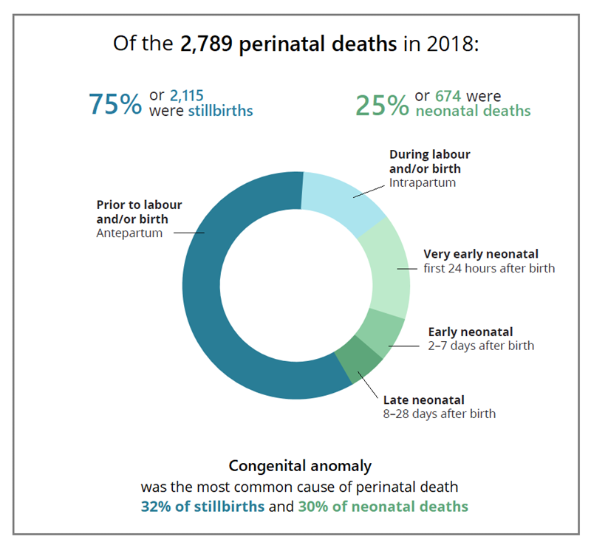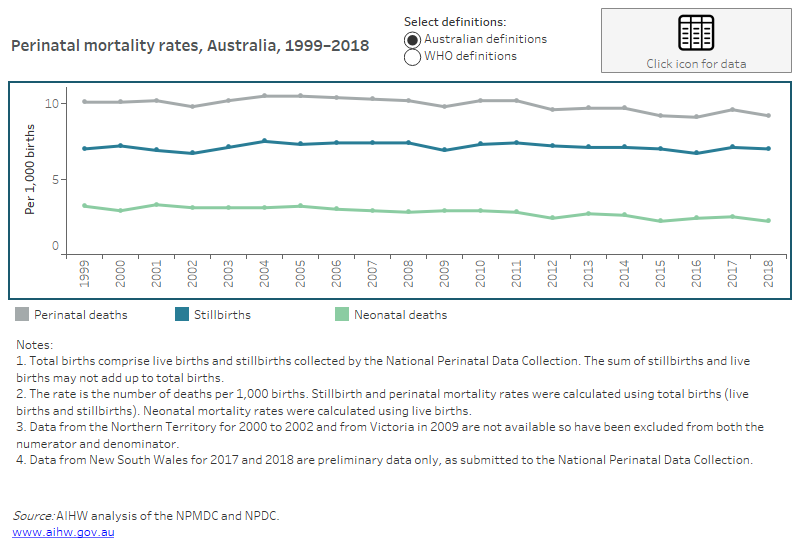Overview of perinatal deaths
Australia is one of the safest places in the world for a baby to be born, yet death occurring within the perinatal period is not uncommon. Every day in Australia, 6 babies are stillborn and 2 die within 28 days of birth (neonatal death).
In 2018, there were:
- 303,029 babies born to 298,630 women
- 2,789 perinatal deaths (0.9% of babies born). Of these deaths, just over 75% were stillbirths (2,115) and just under 25% (674) were neonatal deaths
- 9.2 perinatal deaths per 1,000 births (7.0 stillbirths per 1,000 births and 2.2 neonatal deaths per 1,000 live births).
Although perinatal mortality rates have remained relatively unchanged since 1999, 2 categories decreased over the period:
- neonatal deaths of babies born at 23 weeks gestation or more
- deaths occurring in the third trimester of pregnancy.

International comparison using the WHO definition
The data visualisation below displays perinatal mortality rates in Australia using two different definitions – the Australian and the World Health Organization (WHO) definitions.
For the purposes of international comparison, stillbirths are defined as those occurring in the third trimester– born at 28 weeks’ gestation or more, and/or weighing 1,000 grams or more (WHO 2015). This differs from the standard definitions used for stillbirths in Australia–born at 20 weeks' gestation or more, and/or weighing 400 grams or more.
Neonatal deaths are all registered deaths occurring within 28 days of birth. In Australia, registered deaths are those born at 20 weeks' gestation or more, and/or weighing 400 grams or more.
The WHO definition of stillbirth results in reporting of babies who are larger and more mature than the definition applied in Australia. This means Australian perinatal mortality rates reported using the WHO definition are lower than those reported using the Australian definition.
Using the WHO definitions (stillbirths from the third trimester and all neonatal deaths):
- The rate of stillbirths in Australia has decreased from 3.6 per 1,000 births in 1999 to 2.4 per 1,000 births in 2018.
- The rate of neonatal deaths in Australia is the same using both Australian and WHO definitions, and has decreased from 3.2 per 1,000 live births in 1999 to 2.2 per 1,000 live births in 2018.
Chart title: Perinatal mortality rates, Australia, 1999-2018:
The stacked continuous line graph shows that perinatal mortality rates in Australia, using the Australian definitions, have decreased from 10.1 perinatal deaths per 1,000 total births in 1999 to 9.2 perinatal deaths per 1,000 total births in 2018. The rate of stillbirths in Australia has held steady, with 7.0 per 1,000 births in both 1999 and 2018, while the rate of neonatal deaths in Australia has decreased from 3.2 per 1,000 live births in 1999 to 2.2 per 1,000 live births in 2018.
The graph also allows you to use the WHO definitions of perinatal death. When these definitions are used, the graph shows that perinatal mortality rates have decreased from 6.7 perinatal deaths per 1,000 total births in 1999 to 4.6 perinatal deaths per 1,000 total births in 2018. The rate of stillbirths has decreased from 3.6 to 2.4 per 1,000 births over the same period, while the rate of neonatal deaths has decreased from 3.2 to 2.2 per 1,000 live births in 2018.
The underlying data for this data visualization are also available in the Excel spreadsheet located on the Data page.

Perinatal death data reported by the Australian Bureau of Statistics (ABS) are not directly comparable with the National Perinatal Mortality Data Collection (NPMDC) and National Perinatal Data Collection (NPDC) data.
ABS data are sourced from state and territory registrars of Births, Deaths and Marriages. NPMDC and NPDC data are sourced from midwives and other staff, who collect information from mothers and perinatal administrative and clinical record systems. For more information on the NPMDC and NPDC and definitions used for reporting perinatal deaths please refer to the Technical Notes–Definitions used in reporting.


